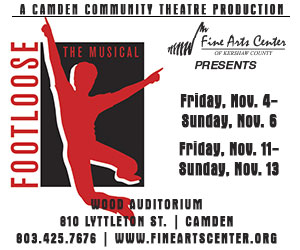Terrance Henderson and the Power to Evolve
By Bonnie Boiter-Jolley
You may know him as the artistic director of Vibrations Dance Company, the founder of Dimensions Dance Festival, director of Trustus Theatre’s recent production of “Smokey Joe’s Café,” or as teacher at Columbia Ballet School, Southeastern School of Ballet, or Logan Elementary. You may admire him for his stunningly honest choreography, intense joy of life, gravity-defying movement, or his big ideas for the arts in Columbia. But chances are, you don’t know nearly enough about dance and theater artist Terrance Henderson.
Packing an impressive arsenal of awards, accolades, and accomplishments, Henderson is internationally recognized for both dance performance and choreography. A native of Newberry, Henderson moved to Columbia as a self-proclaimed Broadway-bound youngster to study theater at the University of South Carolina. It was the 19-year-old Henderson − “T. O.” to friends − who donned his dancing shoes for the first time in an effort to gain an edge in his intended field of musical theater. Now 33-years-old and an active member of both the Columbia theatre and dance scenes, Henderson considers himself an artist, above all else.
A choreographer from the start, Henderson explored ways to express himself beyond the confines of the classical ballet form, a mold he says he didn’t fit. Henderson credits his “bar-to-barre training” with encouraging him to persevere in the face of physical challenges. He remembers realizing the power of his stage presence after attracting crowds of onlookers while dancing in night clubs, and he chose to channel that je ne sais quoi into the studio. This unique energy and joy of movement, along with a tendency toward the theatrical, remain trademarks of Henderson’s work.
Henderson’s choreographic talents were first recognized by Evie Belton, founding director of Vibrations Dance Company, when he performed the solo “That’s Life,” choreographed after a section from Twyla Tharp’s “Nine Sinatra Songs.” Henderson went on to perform the solo at the American College Dance Festival, where he received praise from Fernando Bujones, then artistic director of Southern Ballet Theatre, now Orlando Ballet. Bujones hired the young choreographer to work with his dancers. The result would become a staple in the company’s repertoire.
During his time at USC, Henderson was struck by the divisive nature of what he terms “the system” of dance and the politics that surround it. He comments on a distinct separation imposed on the students in the ballet program and those in the popular West African dance group. This hierarchical conception of dance remains an institution he strives to dismantle. He speaks incredulously of Columbia’s masses of dance students whose limited exposure is confined to the classroom, stunting their understanding of the art and the many forms it may take. Henderson hopes to show students the meaning of training versus exercise, an epiphany he credits his mentor, Kris Cangelosi, with prompting. Cangelosi, founding director of Columbia Contemporary Performance Group, took Henderson to the Jazz Dance World Congress in 2002, where he received his first job offer from the great Gus Giordano, founder of Jazz Dance Chicago. Henderson elected to stay in Columbia to work with Cangelosi, saying he felt he was in the right place. From 2001 to 2003, Henderson assisted, choreographed, taught, and danced for Cangelosi’s company and recalls that he was “a beast.”
“Addicted” to the never-ending fascination of improvement, Cangelosi’s departure motivated self-proclaimed workaholic Henderson to channel his energies into Vibrations Dance Company and his own choreography. In 2004, his work was accepted into the Leo’s choreographic competition at the Jazz Dance World Congress and, in 2009, he received the Bronze Leo for Outstanding Jazz Choreography. Now with the artistic reins of VDC in hand, Henderson views the company as an outlet for people who might not otherwise have the opportunity to dance. Realistically, he notes that this comes with extra monetary and artistic challenges for the company and for him as a choreographer. However, he sees his leadership simply as “one era of Vibrations” and hopes to build a more self-sufficient company that will continue after he moves on. Henderson notes a constant evolution in the climate of dance in general. He speaks passionately about an “era of fusion” in which the new voices of contemporary dance come from a combination of elements. To that end, the perpetual student continues to search for new experiences that will allow him to evolve and grow artistically.
Henderson’s eyes light up as he speaks about “Dimensions: South Carolina Contemporary Dance Festival,” a semi-annual event he founded in 2009. Henderson believes that by bringing a variety of artists and companies to Columbia, via the festival, he can provide an international base of comparison for dancers in the city and set the groundwork for the changes he hopes to see. Henderson views collaboration as a key part of the next step for the arts in Columbia. In his directorial debut with Trustus Theatre, he incorporated dancers from VDC into the production of “Smokey Joe’s Café.” He says he feels the decision brought the song-and-dance show to a new level. Henderson cites Alvin Ailey’s quote, “I believe that the dance came from the people and that it should always be delivered back to the people,” as a guiding principle in his work. Henderson stresses the importance of gaining the trust of one’s audience and community and delivering a product that the people can relate to. Technique is a treat, he says. VDC’s annual production of “Sista Girl and the Soldier: An Urban Nutcracker,” is built around an original story featuring Southern treats Henderson remembers from his childhood and illustrates the director’s desire for inclusivity.
As a teacher, Henderson hopes to expose his students not only to the art itself, but to a different way of being. He is aware that living an artistic lifestyle as a young, Southern, black man is eye-opening for his students and their families. “My work has been my diary since before I even started,” Henderson says. His mission, he says, is to speak through his work and to constantly evolve an idea his father instilled in him at a young age. As an adult, Henderson recognizes a new version of himself in which he can speak through all of his languages to create a fusion of disciplines that he says is both exciting and terrifying. In this vein, he is creating a new work titled “The Black Man …Complex.” The multidisciplinary work will use accounts of Henderson’s own experiences to address ideas about being black as well as sticky Southern issues of sexuality, religion, and the law.
Still coming to grips with the idea of not having to ask permission, Henderson has high expectations for the capital city. “Columbia needs to grow up,” he asserts. His strong belief in the power of the community is apparent as he laments the lack of recognition and respect given to the movers and shakers in Columbia’s arts scene. The people are “not supposed to be so afraid,” he says, “there is plenty.” When it comes to Terrence Henderson and the power to evolve, there certainly is.






.jpg)
